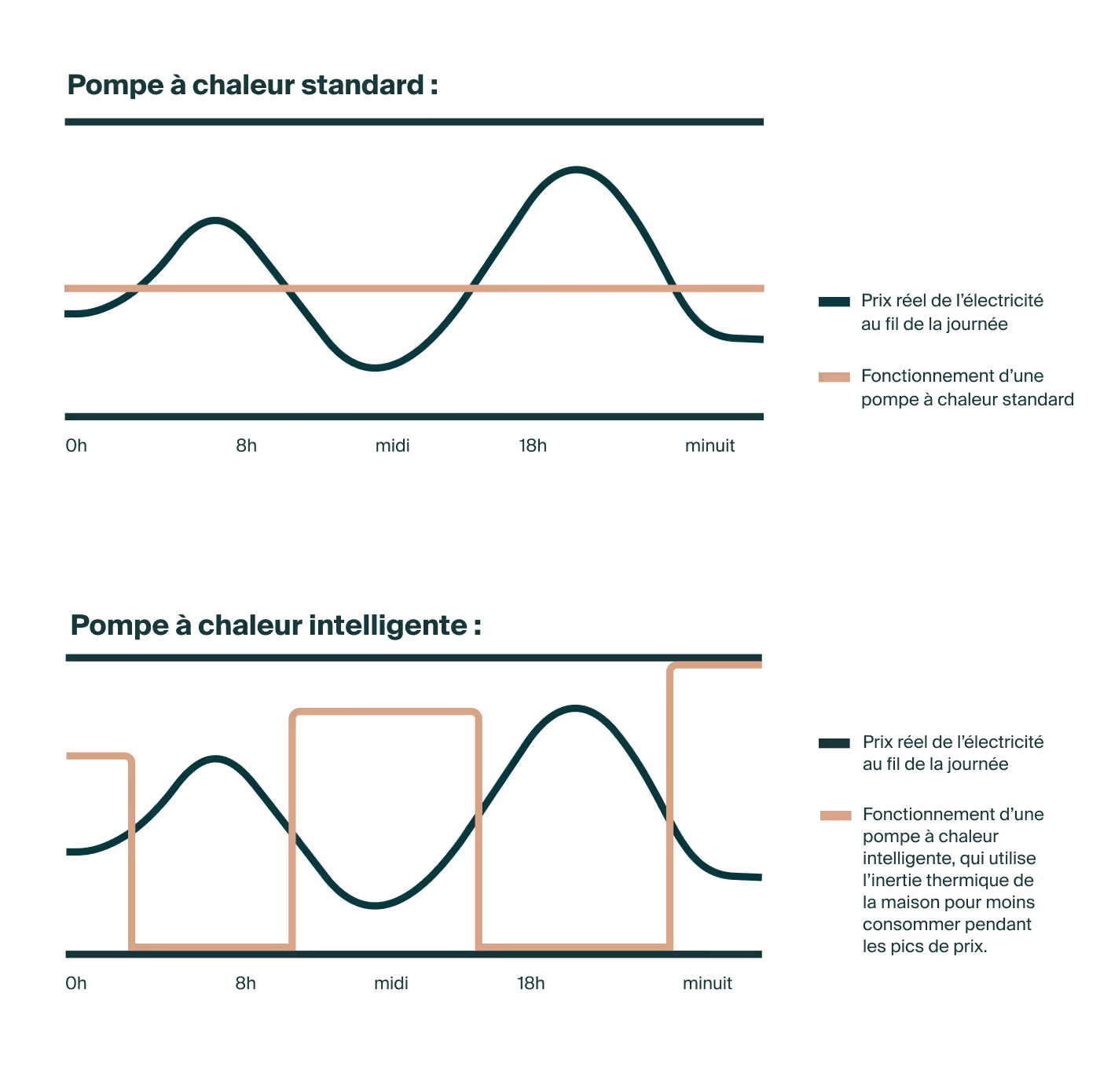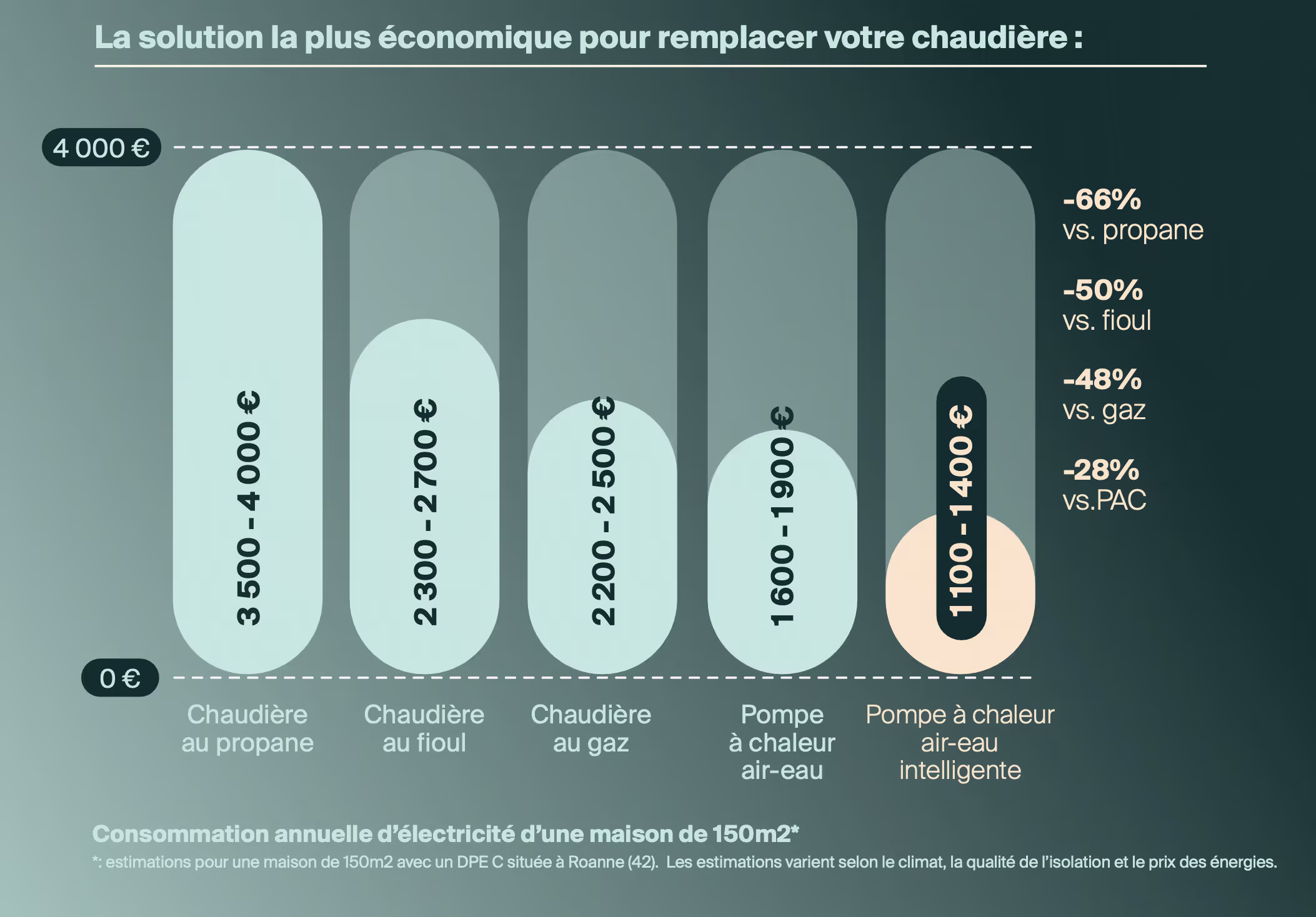Comment fonctionne une pompe à chaleur ?
.jpg)
Heading 1
Heading 2
Heading 3
Heading 4
Heading 5
Heading 6
Lorem ipsum dolor sit amet, consectetur adipiscing elit, sed do eiusmod tempor incididunt ut labore et dolore magna aliqua. Ut enim ad minim veniam, quis nostrud exercitation ullamco laboris nisi ut aliquip ex ea commodo consequat. Duis aute irure dolor in reprehenderit in voluptate velit esse cillum dolore eu fugiat nulla pariatur.
Block quote
Ordered list
- Item 1
- Item 2
- Item 3
Unordered list
- Item A
- Item B
- Item C
Bold text
Emphasis
Superscript
Subscript
L'optimisation énergétique est une priorité pour de nombreux foyers. La pompe à chaleur (PAC) se positionne comme une solution efficace pour réduire la facture énergétique et répondre aux enjeux écologiques. En 2022, plus de 1,1 million de pompes à chaleur ont été installées en France, soit une augmentation de près de 100 % par rapport à 2017, illustrant l'essor significatif de cette technologie dans les foyers français. En plus d’apporter une meilleure efficience au quotidien, la pompe à chaleur connectée permet un contrôle intelligent de sa consommation. Cet article explore en détail le fonctionnement d'une PAC, les avantages de sa connectivité, les étapes pour en installer une et bien d’autres points essentiels pour vous décider.
Principe de fonctionnement général d'une pompe à chaleur
Une pompe à chaleur extrait les calories présentes dans l'air, le sol ou l'eau pour les transférer à l'intérieur de votre maison, réchauffant ainsi l'espace. Ce processus utilise peu d'énergie électrique, rendant la PAC très efficiente. Pour chaque kilowatt d'électricité consommé, la pompe à chaleur peut produire 3 à 4 kilowatts de chaleur, ce qui explique son succès croissant dans les foyers.
Les composants clés d'une pompe à chaleur
Une pompe à chaleur comprend plusieurs éléments clés :
1. le compresseur
2. l'évaporateur
3. le condenseur
4. le détendeur
Ces composants agissent ensemble pour capter la chaleur extérieure, la compresser afin d'augmenter sa température, puis la redistribuer à l'intérieur de la maison. Ce processus est constamment optimisé pour assurer un rendement optimal.
Les principes de l’aérothermie et de la géothermie
Aérothermie : captation de l'énergie dans l'air
L'aérothermie exploite l'énergie calorifique présente dans l'air extérieur, même par temps froid. Une pompe à chaleur aérothermique récupère cette énergie grâce à un fluide frigorigène qui se vaporise à basse température. Ensuite, la vapeur est comprimée pour augmenter sa température, transférant ainsi la chaleur à un circuit de chauffage. Cette technologie est appréciée pour sa simplicité d'installation et ses coûts d'exploitation raisonnables. Elle offre un rendement optimal en chauffage tout en réduisant la consommation d'énergie primaire.
Géothermie : captation de l'énergie dans le sol
La géothermie, contrairement à l’aérothermie, puise dans la chaleur stockée dans le sol, un réservoir thermique stable tout au long de l'année. Une pompe à chaleur géothermique utilise des capteurs enterrés, qu'ils soient horizontaux ou verticaux, pour capter cette énergie. Celle-ci est ensuite transférée via un fluide caloporteur vers l'habitation. Ce système de captation et de transfert d'énergie nécessite une installation plus complexe et coûteuse, souvent à plusieurs mètres de profondeur. Toutefois, il offre un rendement très élevé, particulièrement en climat froid, grâce à la stabilité thermique du sol.
Différence entre une PAC air-air et une PAC air-eau
Pompe à chaleur air-air : fonctionnement et utilisation
La pompe à chaleur air-air extrait les calories de l'air extérieur pour les diffuser sous forme d'air chaud à l'intérieur du logement, à travers des ventilo-convecteurs. Ce système est principalement employé pour chauffer les pièces, mais il ne permet pas de produire d'eau chaude sanitaire.
Pompe à chaleur air-eau : fonctionnement et utilisation
La pompe à chaleur air-eau, quant à elle, capte la chaleur de l'air extérieur pour la transférer vers un circuit d'eau. Ce circuit peut ensuite alimenter un système de chauffage central, comme des radiateurs ou un plancher chauffant, et produire de l'eau chaude sanitaire. Sa polyvalence en fait un choix prisé par de nombreux foyers.
Les avantages d'une pompe à chaleur connectée
La connectivité permet aux utilisateurs de contrôler leur pompe à distance via un smartphone ou une tablette. Ils peuvent ajuster la température en fonction de leurs besoins et de leur mode de vie, que ce soit pour les vacances, les déplacements ou le travail. Cette souplesse améliore non seulement le confort, mais elle génère aussi des économies réelles.
De plus, les systèmes connectés analysent la consommation énergétique de la pompe à chaleur en temps réel. Ils ajustent automatiquement les paramètres pour optimiser l'efficacité. Il est également possible de consulter l’historique de la consommation afin d'identifier les pics. Toutes ces informations permettent d’éviter les surconsommations inutiles !
La plupart des pompes à chaleur fonctionnent toute la journée, sans tenir compte des variations du prix de l’électricité.
Votre pompe à chaleur intelligente utilise l’inertie thermique de votre maison. Elle fonctionne en priorité lorsque l’électricité est très peu chère et évite les pics de prix.

Les étapes d'installation d'une pompe à chaleur
Installer une pompe à chaleur dans votre maison est un processus qui nécessite plusieurs étapes clés pour garantir son bon fonctionnement et son efficacité énergétique. Voici un aperçu des étapes typiques d'une installation de PAC.
1. Évaluation initiale du logement
La première étape consiste à réaliser une évaluation complète de votre logement. Un professionnel analysera les caractéristiques de votre maison, y compris son isolation, sa superficie, et les systèmes de chauffage existants. Cette évaluation permet de déterminer le type de pompe à chaleur le plus adapté à vos besoins spécifiques, ainsi que la puissance nécessaire pour assurer un confort thermique optimal.
2. Choix et dimensionnement de la PAC
Une fois l'évaluation terminée, il est temps de choisir la PAC. Le dimensionnement est crucial : une PAC trop puissante entraînera des surconsommations énergétiques, tandis qu'une PAC sous-dimensionnée ne pourra pas chauffer efficacement le logement. Le professionnel vous aidera à sélectionner le modèle le plus adapté, en tenant compte de vos préférences et des spécificités de votre habitation.
3. Préparation du site d'installation
Avant l'installation, il est nécessaire de préparer le site. Cela peut inclure des travaux de rénovation énergétique pour améliorer l'isolation, la création d'un espace pour l'unité extérieure (dans le cas d'une PAC air-eau ou air-air), et le raccordement aux systèmes de chauffage existants. Cette étape garantit que la PAC sera installée dans des conditions optimales, maximisant ainsi son rendement.
4. Installation et raccordement
L'installation proprement dite de la PAC implique la mise en place de l'unité extérieure et de l'unité intérieure, ainsi que le raccordement de la PAC aux systèmes de distribution de chaleur (radiateurs, plancher chauffant, etc.). Le professionnel s'assurera que tous les éléments sont correctement installés et qu'il n'y a pas de fuites ou de problèmes de circulation du fluide frigorigène.
5. Mise en service et réglages
Une fois la PAC installée, il est temps de procéder à la mise en service. Cela inclut le réglage des paramètres de fonctionnement pour optimiser la performance de la PAC en fonction des besoins énergétiques du foyer. Des tests sont réalisés pour vérifier que la PAC fonctionne correctement, et le professionnel vous expliquera comment utiliser et entretenir votre nouvel équipement.
6. Suivi post-installation et maintenance
Après l'installation, un suivi régulier est nécessaire pour assurer la longévité de votre PAC. Cela comprend des contrôles périodiques pour vérifier son bon fonctionnement et des opérations de maintenance, comme le nettoyage des filtres et le contrôle du niveau de fluide frigorigène. Un entretien régulier permet de maintenir l'efficacité de la PAC et de prolonger sa durée de vie.
Prix et aides disponibles pour l’installation d’une pompe à chaleur
Combien coûte l'installation d'une pompe à chaleur connectée ?
Le coût d'installation d'une pompe à chaleur connectée varie selon le type de système sélectionné (air-air, air-eau, aérothermique ou géothermique). Il dépend aussi de la superficie et des caractéristiques du logement. Les prix se situent généralement entre 8 000 et 20 000 euros, main-d'œuvre incluse. La complexité de l'installation et les adaptations éventuelles pour intégrer la pompe à chaleur au système de chauffage existant peuvent également impacter le coût global.

Quelles sont les aides disponibles pour installer une pompe à chaleur ?
En France, plusieurs aides financières sont disponibles pour faciliter l'installation d'une pompe à chaleur. Parmi elles, on trouve MaPrimeRénov', qui propose des subventions adaptées aux revenus du foyer, ainsi que la prime CEE (Certificats d'Économies d'Énergie), accessible à tous sans condition de ressources.
La TVA réduite à 5,5 % pour les travaux de rénovation énergétique et l'Éco-prêt à taux zéro (Éco-PTZ) sont également à disposition. L'Éco-PTZ permet de financer le reste à charge sans intérêts. Ces aides, qui sont cumulables, visent à rendre l'installation plus abordable tout en encourageant la transition vers des solutions énergétiques durables. Pour en savoir plus, rapprochez-vous d'un installateur agréé de votre région et de votre mairie, qui pourront vous renseigner sur toutes les aides disponibles.
Questions fréquentes sur les pompes à chaleur connectées
Une pompe à chaleur connectée est-elle compatible avec tous les systèmes de chauffage existants ?
Pas encore, mais nous travaillons à faire en sorte que ce soit le cas.
Notre système est compatible avec la plupart des grandes marques de pompe à chaleur air-eau et la majorité des pompes à chaleur air-eau chez Airwell, Atlantic, Daikin, Hitachi, LG, Mitsubishi et Panasonic
Quelles économies d'énergie puis-je espérer avec une pompe à chaleur connectée ?
En souscrivant, vous bénéficiez de -30% sur l’électricité que mylight150 vous fournit les 10 premières années pour votre pompe à chaleur.
Les pompes à chaleur connectées sont-elles difficiles à utiliser ?
Non, les pompes à chaleur connectées sont conçues pour être faciles à utiliser. Elles sont généralement contrôlées via une application mobile intuitive, permettant un réglage simple et un suivi de la consommation en temps réel.
Faut-il sauter le pas ?
Choisir une pompe à chaleur connectée représente un investissement judicieux tant sur le plan économique qu'environnemental. Les bénéfices incluent une réduction significative des factures énergétiques. Chez mylight150, nous optimisons la consommation de votre pompe à chaleur pour éviter les pics où l’électricité est la plus chère. C’est pour réussir cela que nous vous demandons de définir une température cible autour de laquelle nous autoriserons une variation de 1 degré maximum. Par exemple, si vous définissez 20 degrés, vous aurez l’assurance d’une température entre 19 et 21 degrés.
En France, l'adoption des PAC connaît une croissance rapide, avec une augmentation annuelle des installations, ce qui souligne leur popularité croissante. L'avenir de l'optimisation énergétique des logements semble prometteur, avec des technologies de plus en plus intelligentes qui s'intègrent harmonieusement dans la maison connectée de demain.
Estimez vos économies avec notre simulateur


Simulez vos futures économies dès maintenant



.avif)